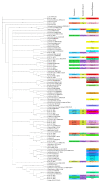Polyenic Antibiotics and Other Antifungal Compounds Produced by Hemolytic Streptomyces Species
- PMID: 36499372
- PMCID: PMC9740855
- DOI: 10.3390/ijms232315045
Polyenic Antibiotics and Other Antifungal Compounds Produced by Hemolytic Streptomyces Species
Abstract
Streptomyces are of great interest in the pharmaceutical industry as they produce a plethora of secondary metabolites that act as antibacterial and antifungal agents. They may thrive on their own in the soil, or associate with other organisms, such as plants or invertebrates. Some soil-derived strains exhibit hemolytic properties when cultivated on blood agar, raising the question of whether hemolysis could be a virulence factor of the bacteria. In this work we examined hemolytic compound production in 23 β-hemolytic Streptomyces isolates; of these 12 were soil-derived, 10 were arthropod-associated, and 1 was plant-associated. An additional human-associated S. sp. TR1341 served as a control. Mass spectrometry analysis suggested synthesis of polyene molecules responsible for the hemolysis: candicidins, filipins, strevertene A, tetrafungin, and tetrin A, as well as four novel polyene compounds (denoted here as polyene A, B, C, and D) in individual liquid cultures or paired co-cultures. The non-polyene antifungal compounds actiphenol and surugamide A were also identified. The findings indicate that the ability of Streptomyces to produce cytolytic compounds (here manifested by hemolysis on blood agar) is an intrinsic feature of the bacteria in the soil environment and could even serve as a virulence factor when colonizing available host organisms. Additionally, a literature review of polyenes and non-polyene hemolytic metabolites produced by Streptomyces is presented.
Keywords: Actinomycetales; Streptomyces; hemolysis; polyene antibiotics; secondary metabolites; soil ecosystem; symbiosis.
Conflict of interest statement
The authors declare no conflict of interest.
Figures


Similar articles
-
Characterization and mapping of secondary metabolites of Streptomyces sp. from caatinga by desorption electrospray ionization mass spectrometry (DESI-MS).Anal Bioanal Chem. 2018 Nov;410(27):7135-7144. doi: 10.1007/s00216-018-1315-0. Epub 2018 Sep 8. Anal Bioanal Chem. 2018. PMID: 30196421
-
New nystatin-related antifungal polyene macrolides with altered polyol region generated via biosynthetic engineering of Streptomyces noursei.Appl Environ Microbiol. 2011 Sep;77(18):6636-43. doi: 10.1128/AEM.05780-11. Epub 2011 Jul 15. Appl Environ Microbiol. 2011. PMID: 21764946 Free PMC article.
-
Polyene antibiotics from Streptomyces mediocidicus.J Nat Prod. 2007 Feb;70(2):215-9. doi: 10.1021/np060542f. J Nat Prod. 2007. PMID: 17315962
-
Biosynthesis and pathway engineering of antifungal polyene macrolides in actinomycetes.J Ind Microbiol Biotechnol. 2013 Jun;40(6):529-43. doi: 10.1007/s10295-013-1258-6. Epub 2013 Mar 21. J Ind Microbiol Biotechnol. 2013. PMID: 23515854 Review.
-
Polyene macrolide biosynthesis in streptomycetes and related bacteria: recent advances from genome sequencing and experimental studies.Appl Microbiol Biotechnol. 2016 May;100(9):3893-908. doi: 10.1007/s00253-016-7474-z. Epub 2016 Mar 29. Appl Microbiol Biotechnol. 2016. PMID: 27023916 Review.
Cited by
-
Biocontrol Potential of Streptomyces odonnellii SZF-179 toward Alternaria alternata to Control Pear Black Spot Disease.Int J Mol Sci. 2023 Dec 15;24(24):17515. doi: 10.3390/ijms242417515. Int J Mol Sci. 2023. PMID: 38139343 Free PMC article.
-
Correlation of renal function with intra-patient variability of tacrolimus concentration among recipients of renal transplants: a 10-year study.Transl Androl Urol. 2025 Feb 28;14(2):220-227. doi: 10.21037/tau-24-564. Epub 2025 Feb 25. Transl Androl Urol. 2025. PMID: 40114823 Free PMC article.
References
Publication types
MeSH terms
Substances
Grants and funding
- 17-30091A/Czech Health Research Council
- No. 17-22572S/Czech Science Fund project
- Strategy AV21 "Diver-sity of life and health of ecosystems" and "Land conservation and restoration"/Research Programme of the Academy of Sciences of the Czech Republic
- SVV 260520/Charles University
- Cooperatio 207032 Immunity and Infection/Charles University
LinkOut - more resources
Full Text Sources
Other Literature Sources

